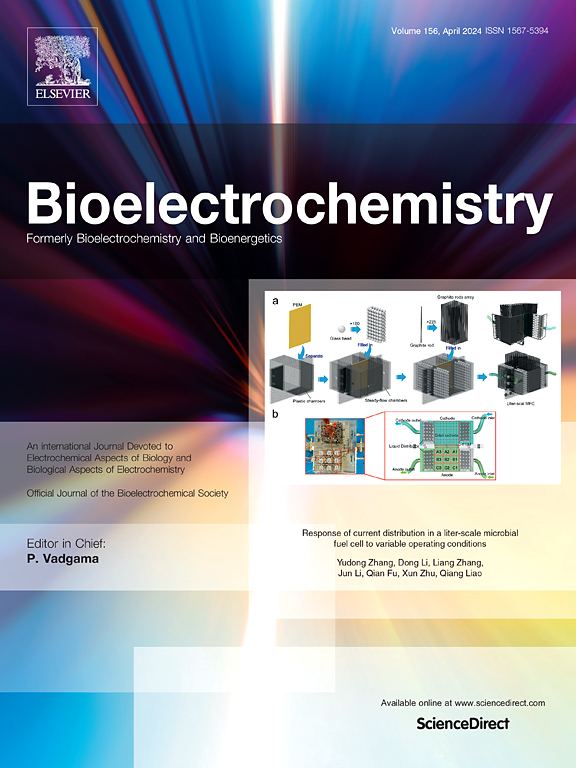The acceleration of localized copper corrosion by extracellular polymeric substances of sulfate-reducing bacteria
IF 4.8
2区 化学
Q1 BIOCHEMISTRY & MOLECULAR BIOLOGY
引用次数: 0
Abstract
Microbial-induced corrosion (MIC) of copper pipelines, especially in sulfate-reducing bacteria (SRB)-rich environments, poses a significant challenge. Despite its importance, the role of SRB-secreted extracellular polymeric substances (EPS) in copper corrosion particularly their time-dependent interactions remains unclear. This knowledge gap limits the development of effective corrosion mitigation strategies. In this study, we investigate the impact of EPS on copper corrosion using electrochemical and surface characterization techniques. Our findings reveal that EPS exhibits a dual role in copper corrosion. During the initial immersion phase (1–3 days), EPS adsorption forms a protective layer, temporarily inhibiting corrosion. In the middle stage (4–8 days), EPS accelerates corrosion by degrading the copper oxide film, as evidenced by a negative shift in the breakdown potential (Eb). In the final stage (9–14 days), uneven EPS coverage exacerbates localized corrosion. Thus, SRB-secreted EPS initially acts as a corrosion inhibitor but later promotes localized corrosion through oxide film disruption and non-uniform coverage. We systematically investigated the mechanisms of EPS-mediated corrosion inhibition across different immersion periods, identifying the critical transition threshold between the inhibition and promotion phases.
硫酸盐还原菌胞外聚合物加速局部铜腐蚀
铜管道的微生物腐蚀(MIC),特别是在富含硫酸盐还原菌(SRB)的环境中,是一个重大挑战。尽管其重要性,srb分泌的细胞外聚合物(EPS)在铜腐蚀中的作用,特别是它们的时间依赖性相互作用尚不清楚。这种知识差距限制了有效缓减腐蚀策略的发展。在这项研究中,我们利用电化学和表面表征技术研究了EPS对铜腐蚀的影响。我们的研究结果表明,EPS在铜腐蚀中表现出双重作用。在初始浸泡阶段(1-3天),EPS吸附形成保护层,暂时抑制腐蚀。在中期(4-8天),EPS通过降解氧化铜膜加速腐蚀,击穿电位(Eb)呈负位移。在最后阶段(9-14天),不均匀的EPS覆盖加剧了局部腐蚀。因此,srb分泌的EPS最初起到缓蚀剂的作用,但随后通过破坏氧化膜和不均匀覆盖促进局部腐蚀。我们系统地研究了不同浸泡时间eps介导的腐蚀抑制机制,确定了抑制和促进阶段之间的关键过渡阈值。
本文章由计算机程序翻译,如有差异,请以英文原文为准。
求助全文
约1分钟内获得全文
求助全文
来源期刊

Bioelectrochemistry
生物-电化学
CiteScore
9.10
自引率
6.00%
发文量
238
审稿时长
38 days
期刊介绍:
An International Journal Devoted to Electrochemical Aspects of Biology and Biological Aspects of Electrochemistry
Bioelectrochemistry is an international journal devoted to electrochemical principles in biology and biological aspects of electrochemistry. It publishes experimental and theoretical papers dealing with the electrochemical aspects of:
• Electrified interfaces (electric double layers, adsorption, electron transfer, protein electrochemistry, basic principles of biosensors, biosensor interfaces and bio-nanosensor design and construction.
• Electric and magnetic field effects (field-dependent processes, field interactions with molecules, intramolecular field effects, sensory systems for electric and magnetic fields, molecular and cellular mechanisms)
• Bioenergetics and signal transduction (energy conversion, photosynthetic and visual membranes)
• Biomembranes and model membranes (thermodynamics and mechanics, membrane transport, electroporation, fusion and insertion)
• Electrochemical applications in medicine and biotechnology (drug delivery and gene transfer to cells and tissues, iontophoresis, skin electroporation, injury and repair).
• Organization and use of arrays in-vitro and in-vivo, including as part of feedback control.
• Electrochemical interrogation of biofilms as generated by microorganisms and tissue reaction associated with medical implants.
 求助内容:
求助内容: 应助结果提醒方式:
应助结果提醒方式:


